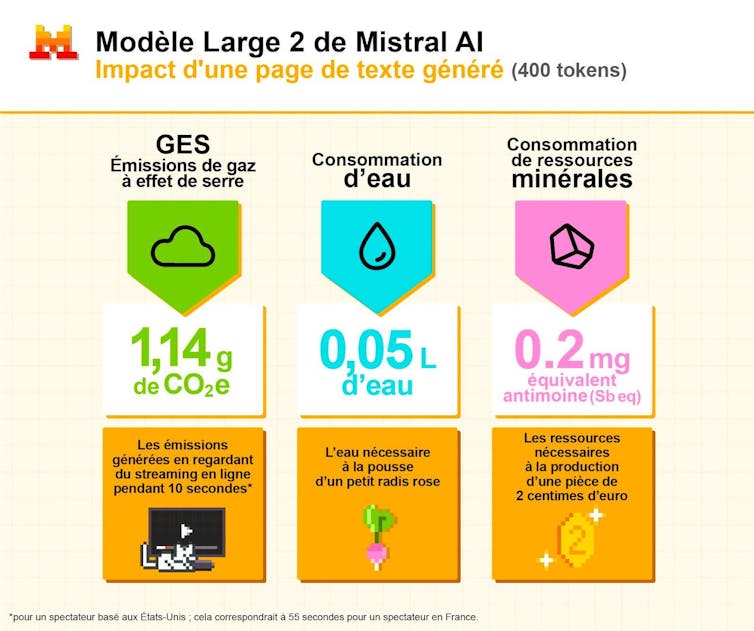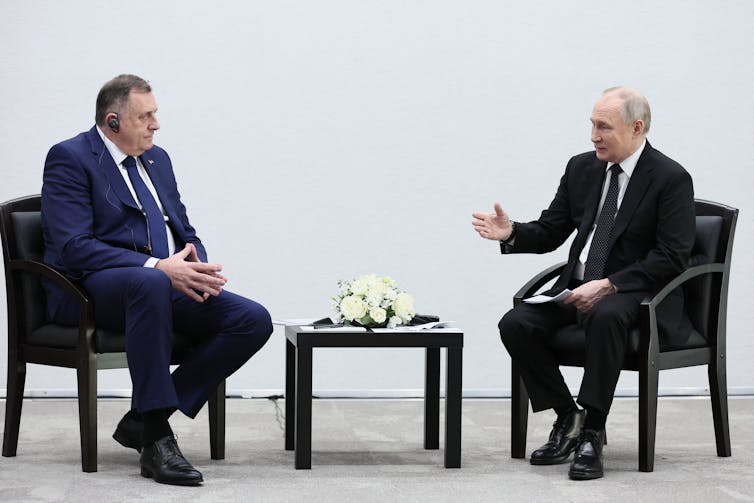Source: The Conversation – France (in French) – By Bisrat Misganaw, Associate Professor of Strategy and Entrepreneurship, Neoma Business School
Souvent présenté comme un levier indispensable pour décarboner nos économies, le numérique est loin d’être une solution miracle. Derrière ses promesses techniques et économiques se cachent des coûts environnementaux et humains croissants. La planète ne bénéficiera pas nécessairement d’une numérisation massive qui risque, au contraire, d’aggraver notre dépendance en termes de ressources et d’énergie.
Au cours des dernières années, la transformation numérique a souvent été présentée comme nécessaire pour atteindre la neutralité carbone. Le Forum économique mondial de Davos, par exemple, estimait que le secteur des technologies numériques constitue le levier d’influence « le plus puissant pour accélérer l’action pour limiter la hausse des températures mondiales à moins de 2 °C ».
Lors de la COP29, fin 2024, la déclaration sur l’action numérique verte (Green Digital Action) affirmait
« le rôle vital des technologies numériques dans l’action climatique », tout l’enjeu étant d’en tirer parti pour atténuer le changement climatique. Mais dans le même temps, cette même déclaration « prenait note avec inquiétude des effets néfastes pour le climat dus aux […] technologies numériques et aux outils, dispositifs et infrastructures connexes ». Au final, le numérique est-il plutôt porteur de promesses ou de menaces pour l’atteinte des objectifs de neutralité carbone ? La déclaration ne le dit pas.
Dans une étude récente, nous avançons que le problème au cœur de l’idée d’un secteur numérique allié du climat repose sur plusieurs hypothèses clés, discutables à bien des égards.
Certes, il existe déjà – et existera à l’avenir – de nombreux exemples qui montrent que la numérisation peut soutenir la cause de la neutralité carbone. Par exemple, lorsqu’il s’agit de solutions qui permettent des gains d’efficacité énergétique, le pilotage de la production décentralisée d’électricité renouvelable, ou encore lorsqu’elles accélèrent les processus de recherche et développement (R&D).
À lire aussi :
Impact environnemental du numérique : l’inquiétant boom à venir
Mais l’argument selon lequel la numérisation de l’économie permettra d’atteindre la neutralité carbone repose sur quatre hypothèses implicites, selon lesquelles elle entraînerait nécessairement :
- davantage de dématérialisation,
- des gains d’efficacité énergétique,
- une réduction des coûts de main-d’œuvre,
- enfin, des décisions économiques plus respectueuses de l’environnement de la part des acteurs économiques.
Or nous montrons qu’aucune de ces hypothèses n’est réaliste.
Ne pas confondre numérisation et dématérialisation
Le lien entre numérisation et dématérialisation, souvent présenté comme allant de soi, doit être interrogé. En effet, la numérisation s’accompagne d’une dépendance aux infrastructures informatiques aux capteurs électroniques utilisés pour convertir et traiter toujours plus d’information sous forme numérique.
Cela implique de construire de nouvelles infrastructures et de nouveaux appareils informatiques. Ces derniers ont une matérialité : leur fabrication implique d’utiliser des ressources minérales limitées, en particulier des métaux rares. Ce problème est encore amplifié par la dépréciation et l’obsolescence plus rapide des appareils informatiques.
Certes, on pourrait dire que ces frais sont compensés par les avantages supplémentaires générés par les services numériques. Cependant, ces avantages ont eux-mêmes un coût pour l’environnement.
À lire aussi :
Pourquoi l’IA générative consomme-t-elle tant d’énergie ?
Cela tient d’abord à leur consommation d’énergie. Par exemple, une seule requête ChatGPT consomme entre 50 et 90 fois plus d’énergie qu’une recherche Google classique. Le fonctionnement des systèmes d’intelligence artificielle (IA) nécessite aussi de grandes quantités d’eau pour le refroidissement des infrastructures informatiques, certains modèles consommant, à large échelle, des millions de litres pendant leurs phases d’entraînement et d’utilisation. Enfin, l’essor des IA génératives pourrait faire croître la demande en cuivre d’un million de tonnes d’ici 2030.
Selon un rapport du ministère de la transition écologique, le secteur du numérique représentait 2,5 % de l’empreinte carbone annuelle de la France et 10 % de sa consommation électrique en 2020. Sans intervention, les émissions de gaz à effet de serre du secteur pourraient croître de plus de 45 % d’ici à 2030. Selon un rapport des Nations unies, en 2022, les data centers du monde entier ont consommé 460 térawattheures d’électricité, soit l’équivalent de la consommation d’électricité annuelle de la France. Il est attendu que cette consommation sera multipliée quasiment par deux en 2026 pour atteindre 1 000 térawattheures.
Les risques d’effet rebond
La promesse de gains d’efficacité énergétique dans le numérique doit également être interrogée, car ces technologies produisent des effets rebond. Les gains d’efficacité font baisser les prix, ce qui augmente la demande, augmentant la consommation d’énergie et la quantité de déchets électroniques produits. La conséquence : une pression accrue sur les limites planétaires.
Ces effets rebond peuvent être directs ou indirects. Un exemple d’effet rebond direct tient à la facilité d’usage des services numériques : en témoigne par exemple l’augmentation constante du nombre de messages en ligne, de visioconférences, de photos et de vidéos stockées sur nos téléphones et/ou dans le cloud, etc.
On peut illustrer l’idée d’effet rebond indirect ainsi : lorsque l’argent, économisé par une entreprise grâce à la réduction des déplacements professionnels (grâce aux réunions virtuelles ou au télétravail), versé sous forme d’augmentations au salarié, lui sert à acheter un billet d’avion pour partir en vacances.

Jorge Franganillo/Flickr, CC BY-SA
Prenons enfin l’exemple des cryptomonnaies, souvent défendues pour leurs avantages en termes de décentralisation financière. Celle-ci s’accompagne d’un coût énergétique élevé : leur consommation d’électricité a dépassé celle de l’Argentine et devrait continuer à augmenter à mesure que la finance décentralisée se développe.
Moins de main-d’œuvre mais davantage d’impacts environnementaux
Le numérique est souvent vu par les décideurs comme une façon de réduire les coûts de main-d’œuvre, et cela dans la plupart des secteurs. La main-d’œuvre a un coût économique, mais elle est également la plus durable de tous les intrants :il s’agit d’une ressource abondante et renouvelable dont l’utilisation n’affecte pas directement les limites de la planète.
La numérisation du travail, si elle permet de réaliser des économies en remplaçant une partie de la main-d’œuvre humaine (et durable) par des machines gourmandes en énergie et en ressources, se fait donc au détriment de l’environnement et amoindrit la durabilité des activités économiques – et non l’inverse.
Même en considérant qu’une partie de la main-d’œuvre déplacée pourrait être absorbée par de nouveaux business models, ces derniers ne seront pas forcément plus durables que les business models d’aujourd’hui. De plus, cela ne ferait que renforcer les tendances actuelles en matière d’inégalités, qui ont des effets délétères sur la durabilité. Une neutralité carbone qui serait atteinte au prix d’un appauvrissement massif de la population et au mépris des objectifs de développement durable des Nations unies paraît inacceptable.
Enfin, l’argument selon lequel le numérique permettrait aux entreprises de prendre des décisions plus soutenables n’est pas fondé. Ces décisions sont prises en tenant d’abord compte de la maximisation des profits, des opportunités de croissance et de l’amélioration de son efficacité en interne, conformément aux structures de gouvernance en place. Les décisions en matière de numérique n’échappent pas à cette règle.
Tant que la maximisation de la valeur pour les actionnaires restera le principe directeur de la gouvernance d’entreprise, il n’y a aucune raison de s’attendre à ce que la numérisation impulsée par les entreprises privilégie le développement d’une économie neutre en carbone plutôt que les préoccupations de rentabilité. Au contraire, les technologies de l’information semblent avoir jusque-là surtout renforcé les tendances actuelles.
Se méfier du solutionnisme technologique
Les arguments qui précèdent montre que la numérisation en soi ne soutient pas toujours la neutralité carbone. Comme toutes les innovations majeures, elle permet d’élargir l’éventail des possibles au plan économique. Cela signifie qu’il existe des opportunités significatives d’investissements durables et transformateurs.
Mais il convient de se méfier des solutions purement technologiques aux problèmes de durabilité, même si elles sont réconfortantes car elles n’impliquent aucun changement réel du statu quo. Ce faux sentiment de sécurité est pourtant précisément ce qui nous a conduits collectivement à épuiser les limites planétaires.
Le numérique peut soutenir la transition verte, mais, pour que ses opportunités puissent être exploitées, un véritable changement dans les processus décisionnels doit s’opérer. Pour l’heure, les États et quelques entreprises restent les seuls niveaux auxquels ces décisions sont prises. En d’autres termes, nous avons besoin d’un déclic collectif pour mieux appréhender les liens entre technologie, énergie et société, sans quoi atteindre la neutralité carbone grâce au numérique ne restera qu’un vœu pieux.
![]()
Les auteurs ne travaillent pas, ne conseillent pas, ne possèdent pas de parts, ne reçoivent pas de fonds d’une organisation qui pourrait tirer profit de cet article, et n’ont déclaré aucune autre affiliation que leur organisme de recherche.
– ref. Pourquoi la transformation numérique n’est pas une voie royale vers la neutralité carbone – https://theconversation.com/pourquoi-la-transformation-numerique-nest-pas-une-voie-royale-vers-la-neutralite-carbone-269636













